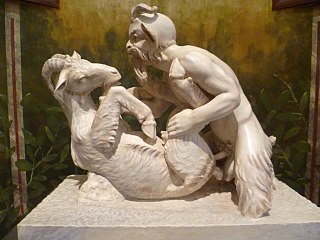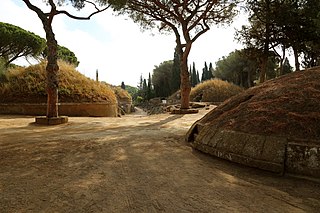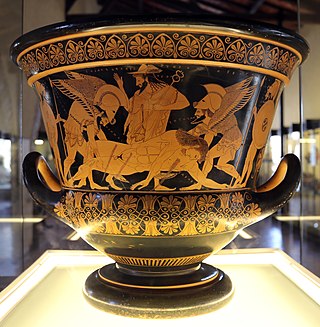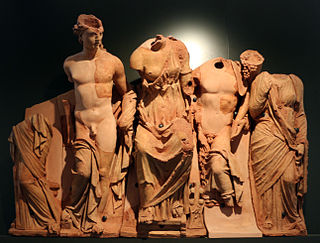
In Greek mythology, Silenus was a companion and tutor to the wine god Dionysus. He is typically older than the satyrs of the Dionysian retinue (thiasos), and sometimes considerably older, in which case he may be referred to as a Papposilenus. The plural sileni refers to the mythological figure as a type that is sometimes thought to be differentiated from a satyr by having the attributes of a horse rather than a goat, though usage of the two words is not consistent enough to permit a sharp distinction. Silenus presides over other daimons and is related to musical creativity, prophetic ecstasy, drunken joy, drunken dances and gestures.

The faun is a half-human and half-deer mythological creature appearing in Greek and Roman mythology.

Erotic art in Pompeii and Herculaneum has been both exhibited as art and censored as pornography. The Roman cities around the bay of Naples were destroyed by the eruption of Mount Vesuvius in 79 AD, thereby preserving their buildings and artefacts until extensive archaeological excavations began in the 18th century. These digs revealed the cities to be rich in erotic artefacts such as statues, frescoes, and household items decorated with sexual themes. The ubiquity of such imagery and items indicates that the treatment of sexuality in ancient Rome was more relaxed than in current Western culture. However, much of what might strike modern viewers as erotic imagery, such as oversized phalluses, could arguably be fertility imagery. Depictions of the phallus, for example, could be used in gardens to encourage the production of fertile plants. This clash of cultures led to many erotic artefacts from Pompeii being locked away from the public for nearly 200 years.

Terracotta, also known as terra cotta or terra-cotta, is a term used in some contexts for earthenware. That is to say it is a clay-based unglazed or glazed non-vitreous ceramic, fired at relatively low temperatures.

A portico is a porch leading to the entrance of a building, or extended as a colonnade, with a roof structure over a walkway, supported by columns or enclosed by walls. This idea was widely used in ancient Greece and has influenced many cultures, including most Western cultures.

Cerveteri is a town and comune of northern Lazio in the region of the Metropolitan City of Rome. Known by the ancient Romans as Caere, and previously by the Etruscans as Caisra or Cisra, and as Agylla by the Greeks, its modern name derives from Caere Vetus used in the 13th century to distinguish it from Caere Novum.

The Euphronios Krater is an ancient Greek terra cotta calyx-krater, a bowl used for mixing wine with water. Created around the year 515 BC, it is the only complete example of the surviving 27 vases painted by the renowned Euphronios and is considered one of the finest Ancient Greek vases in existence.

The Chimera of Arezzo is regarded as the best example of ancient Etruscan art. The British art historian David Ekserdjian described the sculpture as "one of the most arresting of all animal sculptures and the supreme masterpiece of Etruscan bronze-casting". Made entirely of bronze and measuring 78.5 cm high with a length of 129 cm, it was found alongside a small collection of other bronze statues in Arezzo, an ancient Etruscan and Roman city in Tuscany. The statue was originally part of a larger sculptural group representing a fight between a Chimera and the Greek hero Bellerophon. This sculpture is likely to have been created as a votive offering to the Etruscan god Tinia.

The Apollo of Veii is a life-size painted terracotta Etruscan statue of Aplu (Apollo), designed to be placed at the highest part of a temple. The statue was discovered in the Portonaccio sanctuary of ancient Veii, Latium, in what is now central Italy, and dates from c. 510 - 500 BC. It was created in the so-called "international" Ionic or late-archaic Etruscan style.

Etruscan art was produced by the Etruscan civilization in central Italy between the 10th and 1st centuries BC. From around 750 BC it was heavily influenced by Greek art, which was imported by the Etruscans, but always retained distinct characteristics. Particularly strong in this tradition were figurative sculpture in terracotta, wall-painting and metalworking especially in bronze. Jewellery and engraved gems of high quality were produced.

In architecture and the decorative arts, a mascaron ornament is a face, usually human, sometimes frightening or chimeric, whose alleged function was originally to frighten away evil spirits so that they would not enter the building. The concept was subsequently adapted to become a purely decorative element. The most recent architectural styles to extensively employ mascarons were Beaux Arts and Art Nouveau. In addition to architecture, mascarons are used in the other applied arts.

Campana reliefs are Ancient Roman terracotta reliefs made from the middle of the first century BC until the first half of the second century AD. They are named after the Italian collector Giampietro Campana, who first published these reliefs (1842).

The Pontic Group is a sub-style of Etruscan black-figure vase painting.

Etruscan architecture was created between about 900 BC and 27 BC, when the expanding civilization of ancient Rome finally absorbed Etruscan civilization. The Etruscans were considerable builders in stone, wood and other materials of temples, houses, tombs and city walls, as well as bridges and roads. The only structures remaining in quantity in anything like their original condition are tombs and walls, but through archaeology and other sources we have a good deal of information on what once existed.
This two-sided, red figure belly amphora is housed in the Classics wing of the Museum of Fine Arts, Boston. It was bought during Art Basel from Münzen und Medaillen, A.G., October 17, 1963. With flat handles decorated with depictions of ivy, and a double layered foot, it qualifies as a type A amphora. Dated circa 510 BCE, it was likely created by a member of the circle of Euthymides in Athens. It is an early example of red-figure pottery which had been invented only ten years previously. It is regarded by scholars as one of the best examples of the vases that influenced artists in Etruria. It is in excellent condition, but lacks an original find-spot.

Python was a Greek vase painter in the city of Poseidonia in Campania, Southern Italy, one of the major cities of Magna Graecia in the fourth Century BC. Together with his close collaborator and likely master Asteas, Python is one of only two vase painters from Southern Italy whose names have survived on extant works. It has even been suggested that the joint workshop of Asteas and Python in Paestum was a family business.

Etruscan sculpture was one of the most important artistic expressions of the Etruscan people, who inhabited the regions of Northern Italy and Central Italy between about the 9th century BC and the 1st century BC. Etruscan art was largely a derivation of Greek art, although developed with many characteristics of its own. Given the almost total lack of Etruscan written documents, a problem compounded by the paucity of information on their language—still largely undeciphered—it is in their art that the keys to the reconstruction of their history are to be found, although Greek and Roman chronicles are also of great help. Like its culture in general, Etruscan sculpture has many obscure aspects for scholars, being the subject of controversy and forcing them to propose their interpretations always tentatively, but the consensus is that it was part of the most important and original legacy of Italian art and even contributed significantly to the initial formation of the artistic traditions of ancient Rome. The view of Etruscan sculpture as a homogeneous whole is erroneous, there being important variations, both regional and temporal.

Agrippa Postumus had a villa on the slopes of Mount Vesuvius, which was buried in the eruption of 79 AD. The villa lies within the current comune of Boscotrecase, Campania, Italy. The villa is best known for its ancient Roman works of art, especially its frescoes. Because the ash from Mount Vesuvius's eruption preserved the frescoes, they were able to be excavated between 1903 and 1905. The frescoes come from various cubicula, or bedrooms that served as places of sociability and business, along the villa's southern hallway that overlooks the bay of Naples.




























